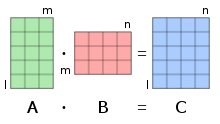
Back ضرب المصفوفات Arabic Умножение на матрици Bulgarian Multiplicació de matrius Catalan لێکدانی ماتریکس CKB Násobení matic Czech Матрицăсене хутласси CV Matrizenmultiplikation German Πολλαπλασιασμός πινάκων Greek Matrica multipliko Esperanto Multiplicación de matrices Spanish

In mathematics, particularly in linear algebra, matrix multiplication is a binary operation that produces a matrix from two matrices. For matrix multiplication, the number of columns in the first matrix must be equal to the number of rows in the second matrix. The resulting matrix, known as the matrix product, has the number of rows of the first and the number of columns of the second matrix. The product of matrices A and B is denoted as AB.[1]
Matrix multiplication was first described by the French mathematician Jacques Philippe Marie Binet in 1812,[2] to represent the composition of linear maps that are represented by matrices. Matrix multiplication is thus a basic tool of linear algebra, and as such has numerous applications in many areas of mathematics, as well as in applied mathematics, statistics, physics, economics, and engineering.[3][4] Computing matrix products is a central operation in all computational applications of linear algebra.
- ^ Nykamp, Duane. "Multiplying matrices and vectors". Math Insight. Retrieved September 6, 2020.
- ^ O'Connor, John J.; Robertson, Edmund F., "Jacques Philippe Marie Binet", MacTutor History of Mathematics Archive, University of St Andrews
- ^ Lerner, R. G.; Trigg, G. L. (1991). Encyclopaedia of Physics (2nd ed.). VHC publishers. ISBN 978-3-527-26954-9.
- ^ Parker, C. B. (1994). McGraw Hill Encyclopaedia of Physics (2nd ed.). McGraw-Hill. ISBN 978-0-07-051400-3.
© MMXXIII Rich X Search. We shall prevail. All rights reserved. Rich X Search